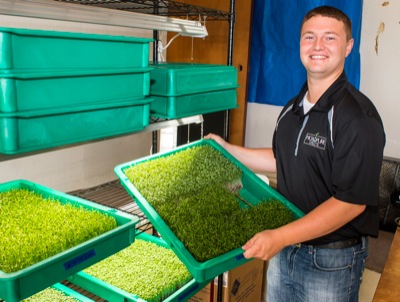Thursday, July 5th, 2018
Celina water project test promising
Major work on the way
By William Kincaid

Photo by William Kincaid/The Daily Standard
Celina Safety Service Director Tom Hitchcock, left, and water treatment plant superintendent Mike Sudman explain the details of a prototype used in a six-week pilot study of new technology aimed at better removing organic solids from raw lake water in pretreatment.
CELINA - City officials are confident a major improvement project at the water treatment plant could get underway within the next six months after seeing promising preliminary results from a six-week pilot test.
Mayor Jef Hazel earlier this year revealed that Celina will continue to draw its drinking water from Grand Lake well into the future after an exhaustive, multiyear search of underground and surface alternatives came up dry.
"We're going to fix what we have even better than what we've ever done so we are absolutely going to be ahead of the curve to get this accomplished," Hazel told the newspaper this week. "This is a major, long, long-term improvement that is going to significantly improve the treatment process that will allow us not only to be more efficient but cost us less in chemicals."
Officials aim to replace the water treatment's clarifiers, which remove solids from the raw lake water, with new advanced models featuring technology that was recently tested at the plant.
The new clarifiers would remove more solids - including algae and other organic substances - during the initial stage of the treatment process, officials said.
Plant superintendent Mike Sudman said the plant currently pumps 12,000 gallons of wastewater containing 1 percent solids a day to the city's lagoons. The new clarifiers would increase that to 12 percent solids, he pointed out.
"If we can get these suspended solids out (up) front, it makes it much easier to treat the drinking water as it does down the (process) line," Hazel said.
A six-week study of new technology focused on better removing organic solids from raw lake water in pretreatment recently concluded, officials said. Katharos Scientific LLC of Colorado had done preliminary work, including creating a prototype of the solid-removing technology designed through Tri-Tech Engineering of Dayton.
Final lab results are not in yet, but Ohio Environmental Protection Agency officials have indicated that initial numbers look encouraging, Hazel said. City officials need OEPA approval before they can proceed with replacing the plant's clarifiers.
The prototype tested on a much smaller scale within the plant employs a process similar to dissolved air flotation technology, which uses tiny bubbles cause solids to to float to the top. However, it's not as equipment intensive as DAF and likely would save the city money down the road by reducing the amount of chemicals used to treat the water.
A traditional DAF unit consists of compressed air, a water pump and "some kind of apparatus as a pressure vessel," Sudman explained.
"Here, we don't have an air compressor so you have less equipment," he said. "The actual pump draws a vacuum of air, so the air draws across (a) UV light. What that does is it negatively charges the oxygen and the nitrogen, so you're forming trace amounts of ozone, trace amounts of hydrogen peroxide and just the negative oxygen itself."
Alum, a positively charged coagulant that contains 10 percent polymer, is added to the raw intake water.
"So now when the positively charged polymer that's in the raw water and the negatively charged air bubbles, they attract. So as they float to the top, it brings all the solids to the top," Sudman continued.
The solids are then skimmed off the top of the water.
Hazel said this is the first pilot test of the new solid-removing technology on a water treatment plant in Ohio. Katharos Scientific has successfully applied it to industrial wastewater cleanups but not water treatment plants, he said.
"This is new. Literally by doing this, we're going to set a new standard for treatment," Hazel said. "This is such an incredibly efficient method of removing all these suspended solids inside."
Officials don't have a firm timeline, but they're confident the OEPA will sign off on their proposed project soon. Hazel and city safety service director Tom Hitchcock said construction could start within six months. It would take as long as nine months to a year as a contractor would have to remove and raise the roof over that part of the plant to be able to fit the new clarifiers into the water treatment plant, Sudman said.
They said they have no cost estimates yet but the project would be financed through an $8 million OEPA Drinking Water Solutions Grant awarded to Celina in 2016 to relocate its water treatment facility, partner with another political subdivision to access water sources, establish pipelines to access suitable water resources or to treat drinking water.
After failing to find a cost-effective alternative underground or surface source of water, city officials decided to stick with Grand Lake water but to find a way to purify it to the fullest extent.
"We have taken (the search for better water quality) from a different direction than when we started when we thought we could go to groundwater, and it simply did not work," Hazel said at a meeting earlier this year. "We looked at a number of elements, including building above-ground reservoirs."
He also had said the game plan moving forward is to "make our drinking water much safer than it ever has been to a point where we can get ahead of any further or future OEPA requirements," stressing drinking water produced today is "fully compliant with the Ohio EPA requirements."
So far, $1.3 million has been spent for engineering services, an ozone replacement system and an advanced oxidation process using ultraviolet light that Sudman last year said would treat for "remaining disinfection byproducts prior to the chlorine being added, any kind of minute pharmaceuticals that could be remaining, algal toxins that could get through the carbon."
The remaining dollars will go toward engineering and replacing the the clarifiers, Hitchcock said.
Anticipating the clarifier replacement, city council members late last month greenlighted an estimated $300,000 project to replace the roof over most of the plant except the corridor housing the clarifiers and remove old lime silos and piping at the water treatment plant. That too would be paid with the drinking water grant.





